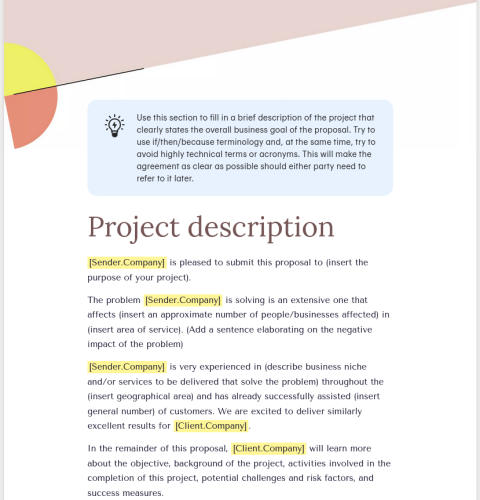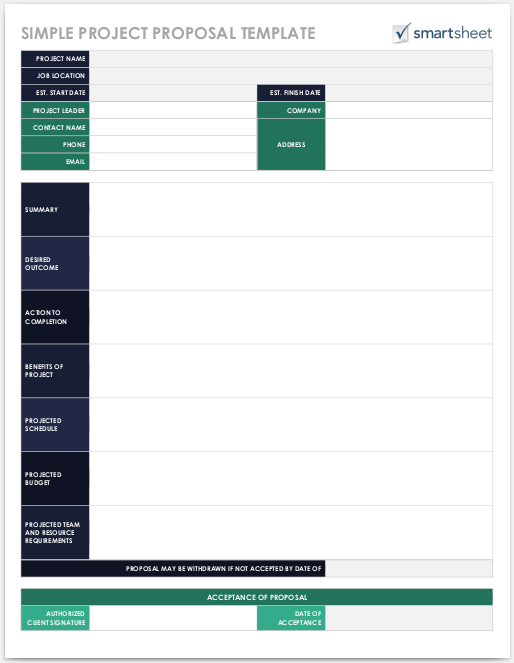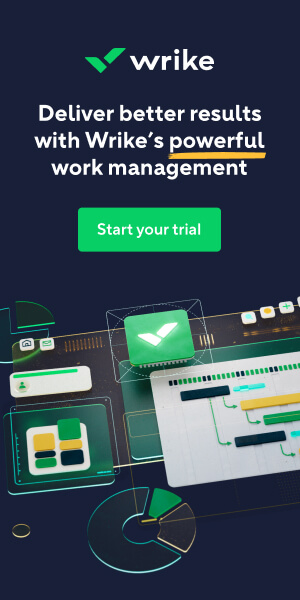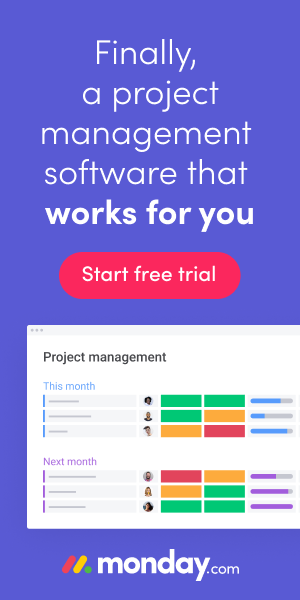A project proposal is a document that an organization, vendor, or contractor prepares to express its interest and capability in taking on a project. Done right, a proposal helps a project manager establish credibility, close clients, acquire funding, and secure the necessary support and approval for projects to be implemented.
Table of Contents
- Project Proposal Templates and Sections to Include
- Types of Project Proposals
- Business Proposal vs. Project Proposal
- Key Components of a Project Proposal
- Writing an Effective Project Proposal
- Featured Partners: Project Management Software
Project approval is probably one of the most exciting parts of project management, and a project proposal sets your project up for success. Referring to a proven business project proposal template or example helps you craft a winning proposal because different types of projects and circumstances warrant different types of proposals. The examples here give an idea of what to include in various proposal types and how to strike the right tone with stakeholders.
Read more: How to Write a Project Proposal
Project Proposal Templates and Sections to Include
A project proposal takes many forms. Depending on your needs, it can be simple or highly detailed, and users can find free project management proposal templates available for their purpose with just a bit of searching online. Any format you choose should at least present a clear solution to a problem, outline the project costs and resources necessary, and provide an anticipated timeline. Here’s a selection of project proposal templates and the kinds of project details to include in each.
Software Development Project Proposal Template
This free project proposal template from Better Proposals enables a team to present the functionality and looks of a software application that the team plans to develop. The following sections will help the team convince clients and get their approval.
- Objective and introduction
- Key features and automated tasks in your software
- Project process and timelines
- Case studies
- Budget, pricing
- Guarantee
- How to get started
- Terms and conditions

Outsourcing Company Project Proposal Template
This simple project proposal template from PandaDoc uses the example of an outsourcing company hoping to stand out from the competition. The customizable, free proposal template is designed to attract potential clients to choose your organization by providing the following important sections:
- Cover page
- Project description
- Project objective
- Overall background
- Overall objectives
- Activities
- Project environment
- Risk analysis
- Success measures
- Alternatives considered
- Project timeline
- Resource requirements
- Appendix

Intuitive Project Proposal Template
This is a project proposal template created by monday.com that is readily available on its platform to users. It lets the project team define all goals and project deliverables, so all stakeholders are aware of what the team needs to accomplish for each week and quarter. The centralized visual workspace allows users to check their goals against their initial plans, executive summary, and other benchmarks with the following sections:
- Problem definition
- Goals and objectives
- Project performance
- Major project milestones
- Cost-benefit analysis

There’s a lot more to monday.com than proposal templates. Read our complete, hands-on review on monday.com.
Simple Project Proposal Template
This simple project proposal template from Teamwork is a customizable example with bullet points that users can adapt for a variety of purposes. Since a project proposal requires a balancing act, it is up to the project team to emphasize the most-known information without overwhelming the stakeholders with too much detail in the suggested sections:
- Project summary
- Background information
- Proposed solution
- Project scope
- Schedule and timeline
- Authorization and conclusion

Project Proposal Template Collection
Smartsheet is a modern project and work management platform for enterprise. In addition to its project management platform, it also provides information, inspirational content, and expert tips and tutorials. It has a template gallery that includes several types of project proposal templates accessible in the links below.

Read our in-depth review on Smartsheet | project-management.com
Types of Project Proposals
The project proposal format you choose should be guided not only by the type of project. A range of other factors affects the content and angle of your project proposal. Such factors include:
- Who the stakeholders are (internal vs. external)
- Whether the proposal was requested in the first place (solicited vs. unsolicited)
- The manner of project proposal solicitation (formal vs. informal)
- Whether the proposal is for an ongoing contract or contract renewal
Internal Project Proposal
Internal project proposals are those you submit to internal stakeholders: your company’s board of directors, upper management, or a specific department in your organization. These groups have the authority to grant you the resources you need or are beneficiaries of the project you’re trying to implement.
For internal project proposals, you should have access to all the data necessary to make your case to internal stakeholders. Or, if not, you know whom to get in touch with. In either case, your goal should be to use the data to support the benefits of your proposed project.
External Project Proposal
Unlike the internal project proposal, an external project proposal is what you submit to parties outside your company (also known as external stakeholders). Examples of such groups are the government, a prospective client, or a community organization.
Generally, an external project proposal requires more research than an internal one. Some relevant information is not readily available to people outside their organizations, so acquiring and packaging relevant information for your project in a cogent way is key for this type of project proposal. Be sure to build in extra time for the extra research and for access to gated information.
Unsolicited Proposal
Unsolicited proposals are those that you generate for prospects without them ever having requested or expected it. This kind of proposal is often borne out of the project team’s initiative or the recommendation of an external party.
Compared to a solicited proposal, making an unsolicited one will require more research and effort to establish the relevance of your project and its viability for the potential client.
To do that, you’ll have to find ways to understand your prospective client’s situation, industry, hurdles, and resources. Without this level of understanding, it’s difficult for you to get the right eyes on your project proposal.
Solicited Proposal
Potential clients request proposals from contractors in what are known as either formal or informal solicited proposals.
A formally solicited proposal comes with a request for proposal (RFP) document. The RFP document outlines the requester’s needs and issues, along with the goals and opportunities they want to achieve through the completion of the project.
Informally solicited proposals, on the other hand, often come without formal documentation. Rather, they emerge out of conversations between vendor and customer, for instance, as an email follow-up to a tradeshow conversation.
Typically, when informally soliciting a project proposal, the client may not solicit submissions from competing vendors. Don’t let this perceived lack of competition lessen the amount of effort you put into your proposal. Research and write it as though your organization is up against your toughest competitors, showing a deep understanding of the client’s needs, articulating your value to the client’s business, and demonstrating the track record of your organization’s project success.
Supplemental Project Proposal
If you need additional resources for your ongoing project, you’ll need to submit a supplemental project proposal to concerned parties. This document can be easy or difficult to make, depending on your circumstances.
Changes in the project scope due to client requests or new findings have to be justified if it’s why you need additional investment. On the other hand, massive discrepancies on your estimates without proper initial disclaimers raise questions and potentially create friction.
Ideally, with proper planning upfront, you won’t need this document. However, extenuating circumstances necessitate this kind of proposal.
Continuation Proposal
A continuation proposal is one of the most straightforward proposals you need to make. It’s essentially an update on ongoing or approved projects. Build your continuation proposal around a concise update on your progress, project milestones met, and performance against budget, along with issues you encountered or anticipated. Providing a clear, concise summary of where the project is and what will be needed to keep it moving will provide the customer with the situational awareness they need to make their decision.
Renewal Project Proposal
A renewal project proposal is what you send if your project contract is about to end or has been terminated. It’s a request for reinvestment so you can restart your project operations. Depending on the reasons for termination, writing a it can be easy or difficult.
If your project was terminated because of positive or neutral reasons (e.g., project completion, end of contract), you simply have to establish why it will be good for them to invest in you again.
If the contract was terminated for unfavorable circumstances (e.g., missed deadlines, prematurely depleted resources), you’ll have to take time to evaluate the causes of the past mistakes and guarantee they won’t happen a second time.
The document is similar to your original proposal to the extent that you’re explaining what you’ll deliver for the client in the future. However, depending on the circumstances of the contract’s expiration, your organization may have a lower hurdle to clear because the client has first hand experience with your organization.
Business Proposal vs Project Proposal
A business proposal is a document that aims to attract a potential client with what a company sells or does as a service. It explains product or service features in consideration of what the client may need in its business. So a business proposal explains how a company can provide a solution to a specific customer’s problem. Companies can use a business proposal template to standardize their documents.
A project proposal, on the other hand, is a professional proposal document that outlines what stakeholders, external or internal, should know about a project. This includes, at the least, the timeline, budget, objectives, and goals. It summarizes project details and sells an idea with the aim of getting the approval of the stakeholders for the initiative.
With these definitions, a business proposal usually comes first before a project proposal. The business document introduces a provider company to a client company. If the client believes that the selling company can provide solutions, it can further request a project proposal to solve a particular business problem.
The types of business proposals and project proposal can be similar in nature, such as solicited or unsolicited, formal or informal. But the contents are different because the purpose of each document is also different. It can have some similar sections, such as an executive summary, terms and conditions, and acceptance page, but each document will be different in its detail.
The primary reason for a business proposal is to solicit or develop a business opportunity. Teams write a project proposal mainly to gain stakeholder buy-in, secure funding, and allocate company resources for the project.
Project Proposal vs Business Case
Another term that can cause confusion is ‘business case’. Some use it interchangeably with project proposal, but a business case comes after the project proposal. While teams develop a project proposal in the early stages of an initiative, a business case comes after the project proposal.
The project proposal focuses on the vision, deliverables, benefits, time, cost, and impact of the project to the organization. The business case explains in more detail the why, what, how, and who’s of a project. It also explains financial requirements in greater detail.
Some teams prepare both documents separately, while others combine them in one comprehensive project proposal document.
Key Components of a Project Proposal
A good project proposal should communicate the significance of the project, the team’s capabilities, and project feasibility and viability. There’s no one way to make a proposal. But here are the essential components to include in your project proposal outline.
Problem Statement
- Establish why your prospect should approve your project
- Display a thorough understanding of your beneficiary’s industry and situation
- Help them see the opportunities
Vision and Benefits
- Research from the stakeholders’ perspectives how and why this project matters
- Articulate how the proposed project positively impacts their organizational goals, values, and priorities
Goals and Objectives
- Set SMART goals and measurable objectives that support the vision and achieve the benefits
- Identify specific parameters that will define what a successful project will look like
- Ensure your stakeholders understand how these all contribute to solving their problems
Project Plan and Methods
- Support your stated goals with information on how you and your team plan to achieve them
- Convince your client of your team’s capability to fulfill your promises
- Share the project deliverables they can expect from you
- Provide a timeline and how you’ll report progress
Resources
- Communicate your prospect’s role and responsibility in making the project happen
- Be transparent about the financial, material, manpower, and other resources you need to implement your plans
- Estimate costs and draft contingency plans as accurately as possible
Executive Summary
- Summarizes the most relevant parts of the project proposal
- Make the executive summary easily skimmable
Writing an Effective Project Proposal
Writing an effective proposal is an essential skill in project management. Regardless of how good you are at project execution, securing opportunities for you to implement your projects is the critical first step.
Refine your skills in communicating your and your projects’ value and viability by consulting one of several free templates available based on project type.
When making a template your own, consider the audience and the circumstances that give rise to the proposal in the first place. With this advice, you’re well on your way to writing a stellar project proposal that earns approval and promotes mutually beneficial business goals for you and your clients.
Read next: How to Successfully Host a Project Kickoff Meeting













